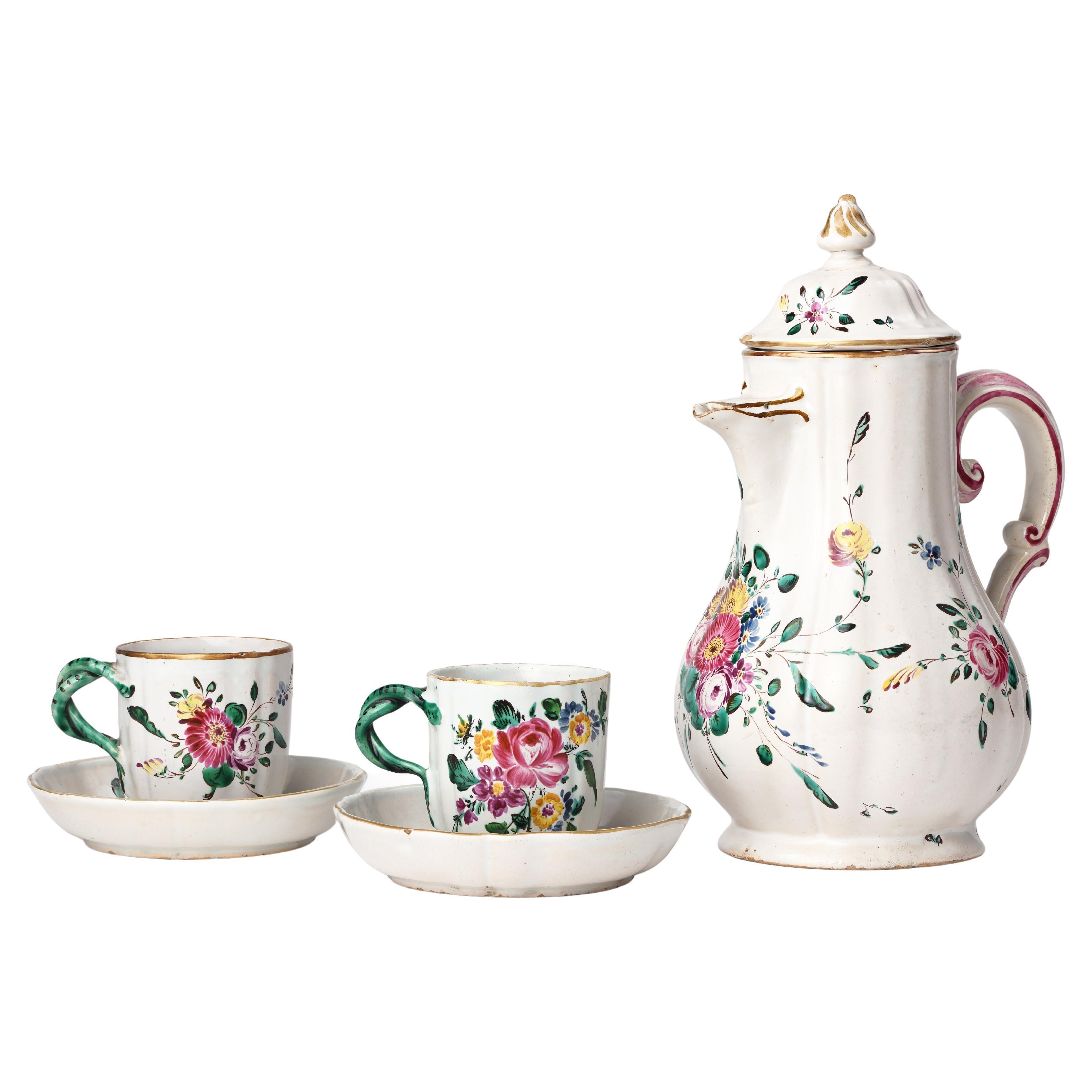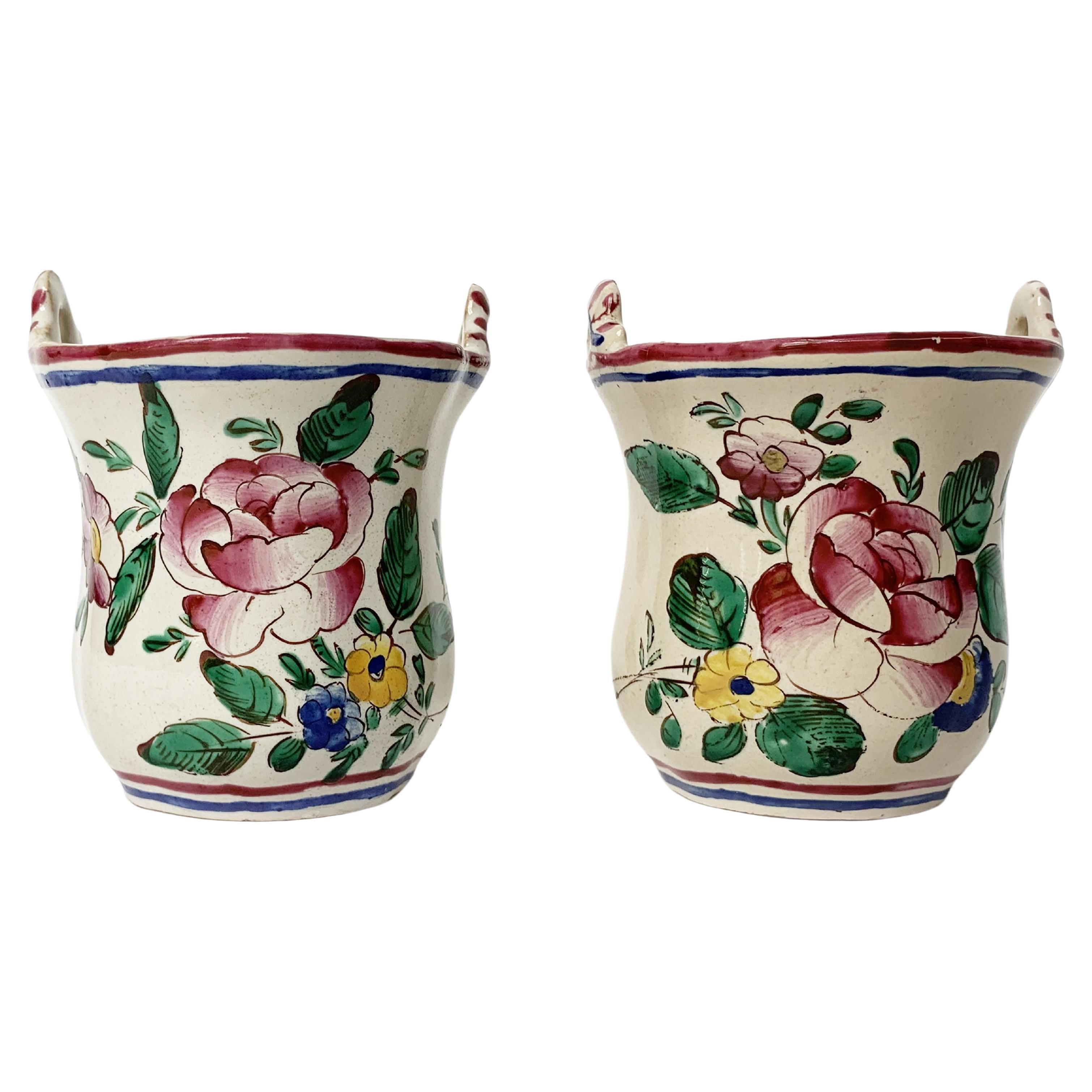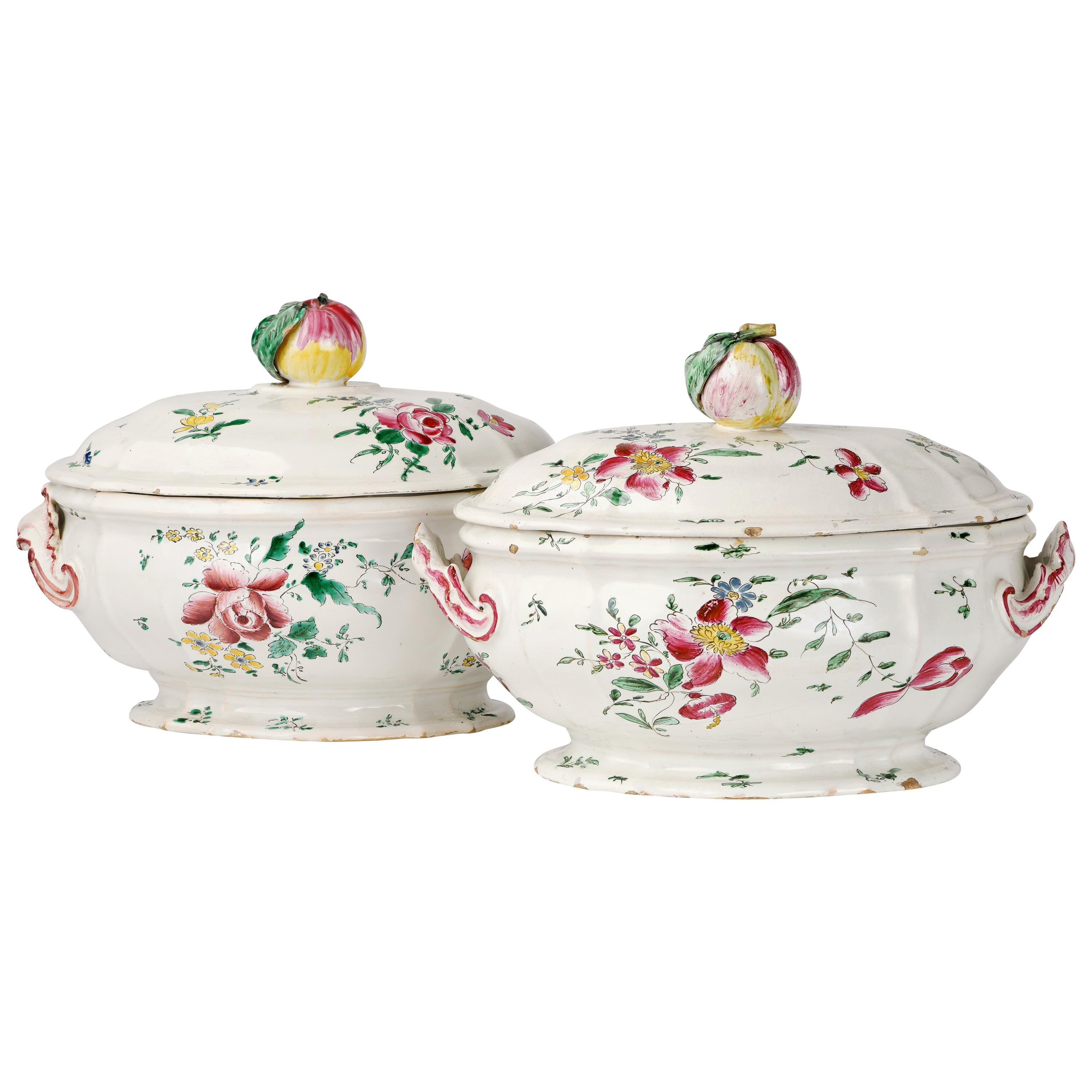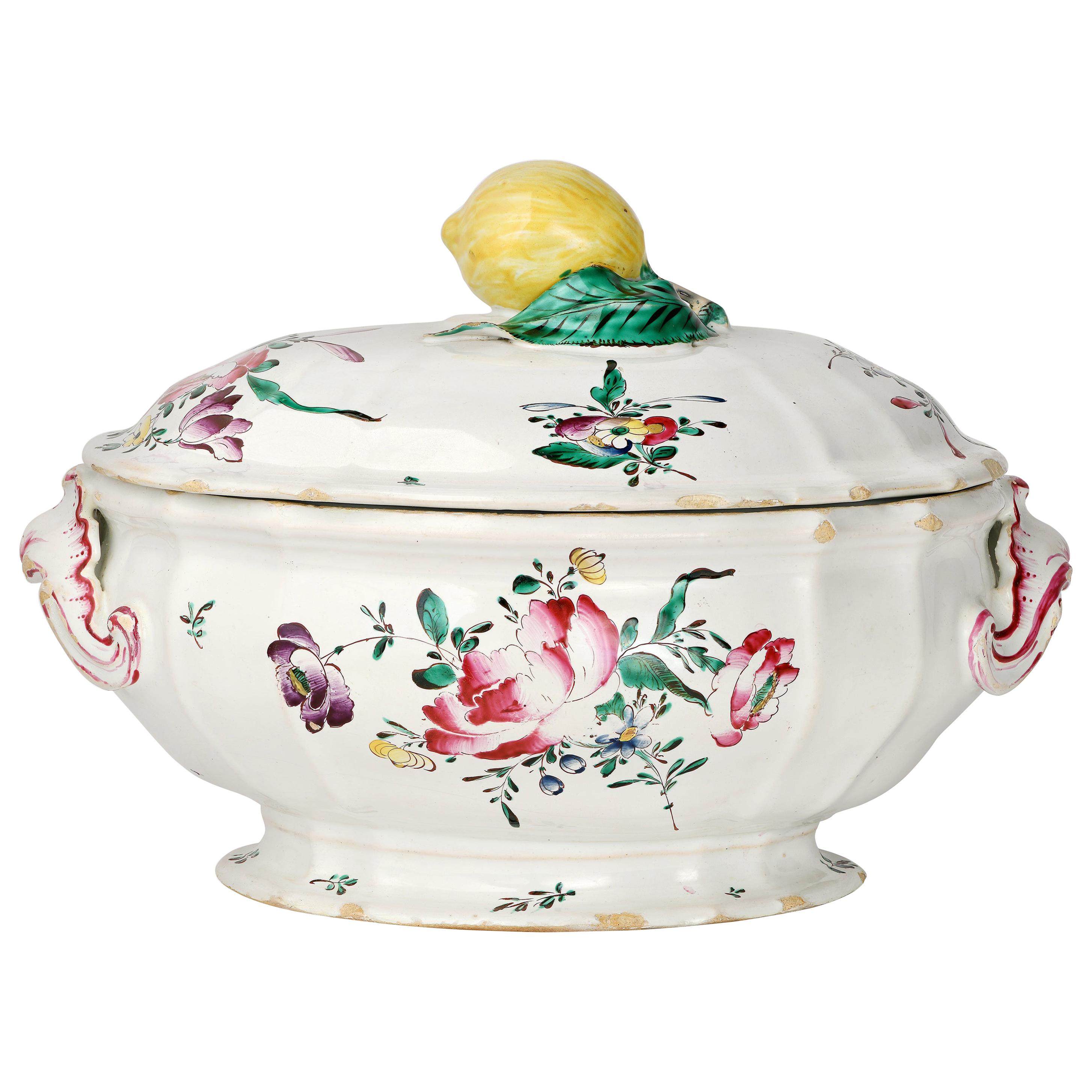Items Similar to Ancient Italian Coffee Pot, Coppellotti Manufacture, Lodi, Circa 1740
Video Loading
Want more images or videos?
Request additional images or videos from the seller
1 of 21
Ancient Italian Coffee Pot, Coppellotti Manufacture, Lodi, Circa 1740
About the Item
Coffee pot
Antonio Maria Coppellotti Manufacture
Lodi, Circa 1740
High fire polychrome maiolica
It measures: 7.87 in x 6,49 x 5.11 (20 cm x 16,5 x 13); weight 1.23 lb (561 g)
State of conservation: the coffee pot is in excellent condition except for some chipping from use and some subtle, insignificant heat fêlures along the body. The lid has been restored.
The coffeepot, with an enlarged, ribbed, pyriform body and belly, rests on a barely visible flat foot. It has a beak pourer and shaped handle; the lid rises low above the body, is poded and surmounted by a button knob (restored).
The shape is typical of the works produced by the Lodi factories of the first half of the 18th century and is inspired by silverware models.
On the front of the container, the high-fire polychromy decoration shows a couple of figures dressed in "Turkish-style" on a clump of earth: there is a seated woman and a man standing between two small trees coming towards her.
On one side, on another clump of earth, you can see a building with towers and, on the other side, on two separate clumps, a fawn and a bird on the ground near some small trees. The composition is completed by insects and butterflies, some of which are painted on the handle. The lid, consistent in shape, bears an ornament with rocaille that is stylistically different from the rest of the composition.
The brand with the “AMC” monogram is painted under the foot and here it is also associated with the word "Lodi" in cobalt blue.
The coffee pot can be attributed with certainty, thanks to the brand mark, to the well-known Lodi manufacture of Anton Maria Coppellotti in the years around 1740. It was around this time that the factory abandoned the Baroque decorative canons for the new trends in fashion, including that of the “paesini e figure” (villages and figure), a style which catalogs a few and rare known examples of closed forms and a greater number of open forms (non capisco bene cosa volete dire per "closed and open forms").
The coffee pot was exhibited in the famous Lombard maiolica exhibition in 1964 (G. Gregorietti, Maioliche di Lodi, Milano e Pavia, catalogo della mostra, Museo Poldi Pezzoli, Milano 1964, n. 72) and still bears the display label under the base.
It also bears the label of Rodolfo Subert, antique dealer and great-grandfather of this writer, whose shop in Galleria Vittorio Emanuele II in Milan was destroyed by bombing in August 1943.
A comparative example, without a lid, is kept in the Musèe National de la Céramique in Sévres (inv. 02CE4592- 908511). Another one, also without a lid, is present in a private collection (Felice Ferrari, La ceramica di Lodi, Lodi 2003 p. 157).
The first mention of the Coppellotti family as potters comes from archival documents which record the official request of an unknown Giovanni Coppellotti to open a majolica factory in Lodi in 1674.
The factory, located near the church of St. Philip seems to have been immediately quite successful. However, it was only in 1679, when the management of the factory passed to Antonio Giovanni Maria Coppellotti – the son or perhaps grandson of the original Giovanni - that the production reached the peak of success and became an example for the main Italian manufactures of the time, especially those in Veneto and Liguria. In 1728 the factory had to move outside the city walls at the behest of the authorities, who feared the possibility of fires.
The activity continued until about 1750, the year of Anton Maria's death and resumed later with his son, Bassano Coppellotti, under the guide of some other directors, among whom we note: first, G. Moroni, followed by Giulio Berinzaghi and in 1771 Pedrinazzi. Finally, in 1787 a new municipal ordinance ordered the definitive closure of the manufactory.
The maiolica produced during the initial period are characterized by the use of a thick, velvety enamel and have ornaments ranging from monochrome turquoise with Italian (ruins, castles, flowers) and French motifs ("rabeschi", ramage), to decorations in the manner of Chinese porcelain and oriental inspiration.
Of particular importance are ornaments of Baroque fruit which show the amazing relief effects produced by using the red tone called "Armenian bolus". This great variety of decorations appeared between 1735 and 1740 by which time, alongside the production of turquoise monochrome, polychromy with high fire technique was firmly established. The brand precisely identifying the maiolica of this factory is rare and uses a woven "AMC" monogram. It was sometimes done in different colors and was sometimes accompanied by the names of the painters and modelers of the manufacture.
Bibliography:
C. Baroni, La maiolica antica di Lodi, in “Archivio storico lombardo” LVIII, 1930, pp. 448 s., 455-457.
A. Minghetti, I ceramisti italiani, Roma 1946, p. 129.
S. Levy, Maioliche settecentesche lombarde e venete, Milano 1962, pp. 15-17, tavv. 121-150.
G. Gregorietti Museo Poldi Pezzoli, Maioliche di Lodi, Milano e Pavia, catalogo della mostra, Milano 1964, n. 72.
A. Novasconi - S. Ferrari - S. Corvi, La ceramica lodigiana, Milano 1964, pp. 23, 27, 34-36, 47, ill. pp. 53-121.
O. G. C. Sciolla, Museo civico di Lodi, Bologna 1977, pp. VIII s.; tavv. pp. 72-76, 78.
M. L. Gelmini, Maioliche lodigiane del ‘700, Milano 1995.
Felice Ferrari, La ceramica di Lodi, Lodi 2003.
- Creator:Antonio Maria Coppellotti (Manufacturer)
- Dimensions:Height: 7.88 in (20 cm)Width: 6.5 in (16.5 cm)Depth: 5.12 in (13 cm)
- Style:Rococo (Of the Period)
- Materials and Techniques:Maiolica,Glazed
- Place of Origin:
- Period:1730-1739
- Date of Manufacture:circa 1740
- Condition:Repaired: The lid has been restored. The lid has been restored. The coffee pot is in excellent condition except for some chipping from use and some subtle, insignificant heat fêlures along the body.
- Seller Location:Milano, IT
- Reference Number:1stDibs: LU4352231338932
About the Seller
4.3
Vetted Seller
These experienced sellers undergo a comprehensive evaluation by our team of in-house experts.
Established in 1860
1stDibs seller since 2018
Typical response time: 4 hours
Associations
International Confederation of Art and Antique Dealers' Associations
- ShippingRetrieving quote...Ships From: Milano, Italy
- Return PolicyA return for this item may be initiated within 14 days of delivery.
More From This SellerView All
- Maiolica Pitcher Antonio Maria Coppellotti Manufacture, Lodi, Circa 1735By Antonio Maria CoppellottiLocated in Milano, ITMajolica pitcher Antonio Maria Coppellotti Manufacture Lodi, circa 1735 Majolica decorated in cobalt blue monochrome It measures 7.36 in hight x 8.07 x 4.52 (h 18.7 cm x 20.5 x 11.5...Category
Antique 1730s Italian Baroque Ceramics
MaterialsMaiolica
- Ancient Italian Assortment Coffe Pot and Cups, Lodi, Circa 1765-1770By Antonio FerrettiLocated in Milano, ITA coffee pot and two cups with saucers Antonio Ferretti Manufacture Lodi, Circa 1765-1770 Maiolica polychrome decorated “a piccolo fuoco” (third fire). They measure: coffee pot: 9....Category
Antique 1760s Italian Rococo Ceramics
MaterialsMaiolica
- Small Maiolica Flower Pots, Ferretti Manufacture, Lodi, circa 1770-1780By Antonio FerrettiLocated in Milano, ITTwo maiolica flower pots Antonio Ferretti Manufacture Lodi, Circa 1770 - 1780 Maiolica polychrome decorated “a piccolo fuoco” (third fire) The...Category
Antique 1770s Italian Rococo Ceramics
MaterialsMaiolica
- Maiolica Italian Pitcher Ferretti Manufacture, Lodi Circa 1770 - 1780By Antonio FerrettiLocated in Milano, ITMaiolica pitcher Antonio Ferretti Manufacture Lodi, circa 1770-1780 Maiolica polychrome decorated “a piccolo fuoco” (third fire). It measures 8.66 x 8.66 x 4.33 in (22 x 22 x 11 ...Category
Antique 1770s Italian Rococo Ceramics
MaterialsMaiolica
- Pair of Italian Maiolica Tureens, Ferretti Manufacture, Lodi Circa 1770 - 1780By Antonio FerrettiLocated in Milano, ITPair of maiolica tureens Antonio Ferretti Manufacture Lodi, circa 1770-1780 Maiolica polychrome decorated “a piccolo fuoco” (third fire). a – 8.66 x 11.02 x 7.48 in (22 x 28 x 19...Category
Antique 1770s Italian Rococo Ceramics
MaterialsMaiolica
- Italian Maiolica Ancient Tureen, Lodi, 1770-1780By Antonio FerrettiLocated in Milano, ITMaiolica tureen Antonio Ferretti Manufacture Lodi, circa 1770-1780 Maiolica polychrome decorated “a piccolo fuoco” (third fire). It measures 9.05 x 12.59 x 9.05 in (23 x 32 x 23 cm) ...Category
Antique 1770s Italian Rococo Ceramics
MaterialsMaiolica
You May Also Like
- Sitting Dog, Delft, circa 1740By DelftLocated in Verviers, BEThe molded dog is sitting on a rectangular base and has its head raised and turned, and his snout opened. He wears a red-dotted collar. The dog is painted in blue, the stand in blue ...Category
Antique Mid-18th Century Dutch Baroque Delft and Faience
MaterialsCeramic, Faience
- Dansk Design Coffee Pot by QuistgaardBy Jens Quistgaard, DanskLocated in San Diego, CABeautiful tall ceramic coffee pot designed by Quistgaard for Dansk circa 1950s, in great condition no chips or cracks.Category
20th Century Danish Scandinavian Modern Ceramics
MaterialsPottery
- Vallauris, France, Coffee Pot, Lidded Bowl and a Coffee MugLocated in Copenhagen, DKVallauris, France, coffee pot, lidded bowl and a coffee mug. Luster glaze. 1960/70s. In good condition with an insignificant small chip on the spout. Marked. Coffee pot measures:...Category
Vintage 1960s French Tableware
MaterialsCeramic
- Studio Pottery Weed Pot, circa 1975Located in Costa Mesa, CAStudio Pottery weed pot / vase. circa 1975.Category
20th Century American Mid-Century Modern Vases
MaterialsCeramic
- Italian Chiminea Preserve Pot #11Located in Bradenton, FL19th Century Italian ceramic chiminea preserve pot with handles. These pots were used to preserve food such as fruits, meat or vegetables. They were designed to be used in conjunctio...Category
Antique 19th Century Italian Late Victorian Ceramics
MaterialsCeramic
- Jens H. Quistgaard for Bing & Grøndahl, Relief Coffee PotLocated in Copenhagen, DKJens H. Quistgaard (1919-2008) for Bing & Grøndahl / Nissen Kronjyden. Relief coffee pot in glazed stoneware. Beautiful glaze in mustard yellow shades. 1960s. Measures: 24 x 22 cm...Category
Vintage 1960s Danish Scandinavian Modern Tableware
MaterialsStoneware
Recently Viewed
View AllMore Ways To Browse
Ancient Silver
Ancient Glass
Ancient Ceramics
Glass Coffee Pots
Glass Pot Lids
Glass Pot Lid
Antique Coffe Pots
Antique Coffee Pots
Antique Coffee Pot
Coffee Pot Antique
Antique Italian Figures
Ancient Birds
L M Silver
Antique Coffee Pots Silver
French Rococo Silver
Antique Glass Coffee Pots
Antique Glass Knobs
Glass Knobs Antique





